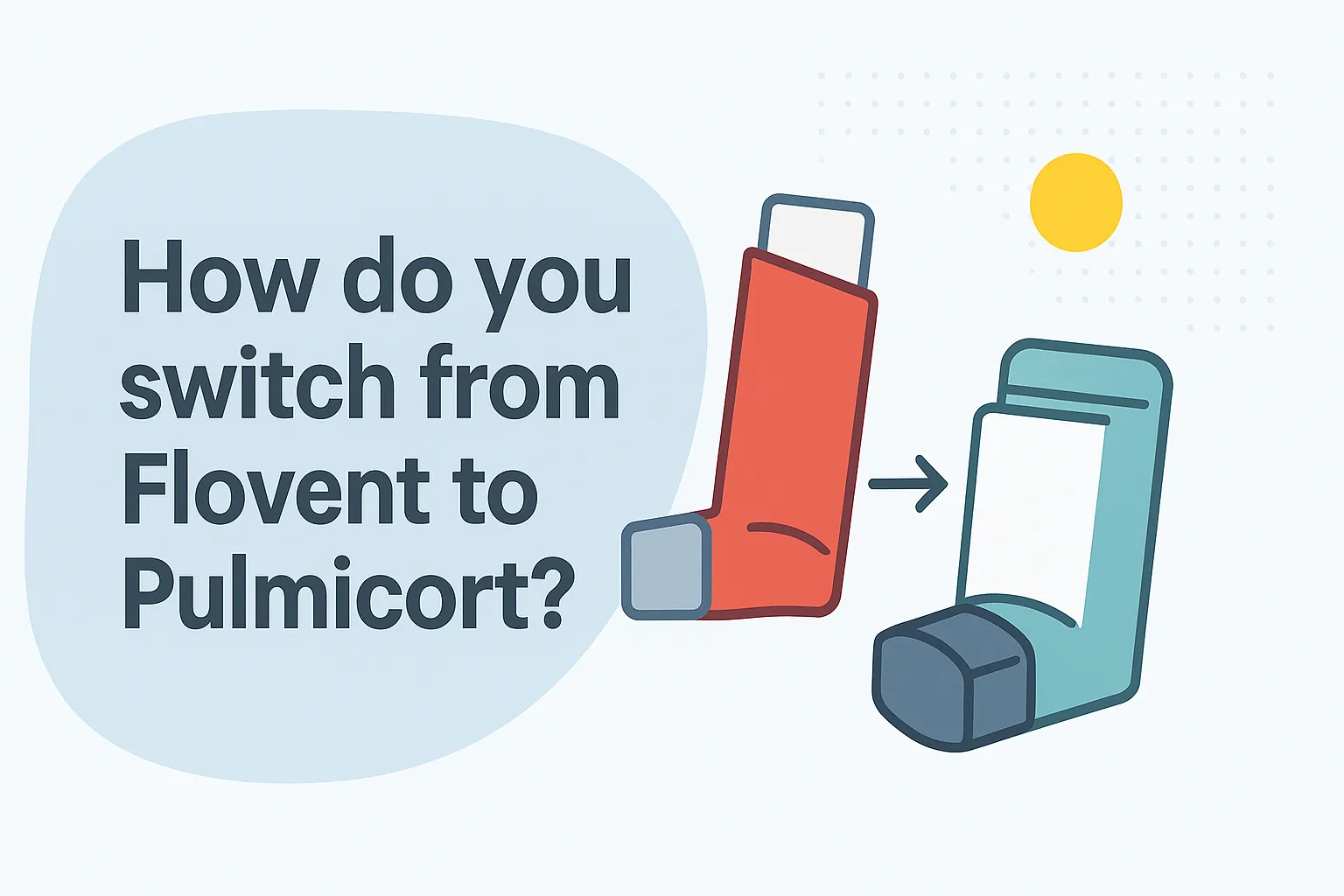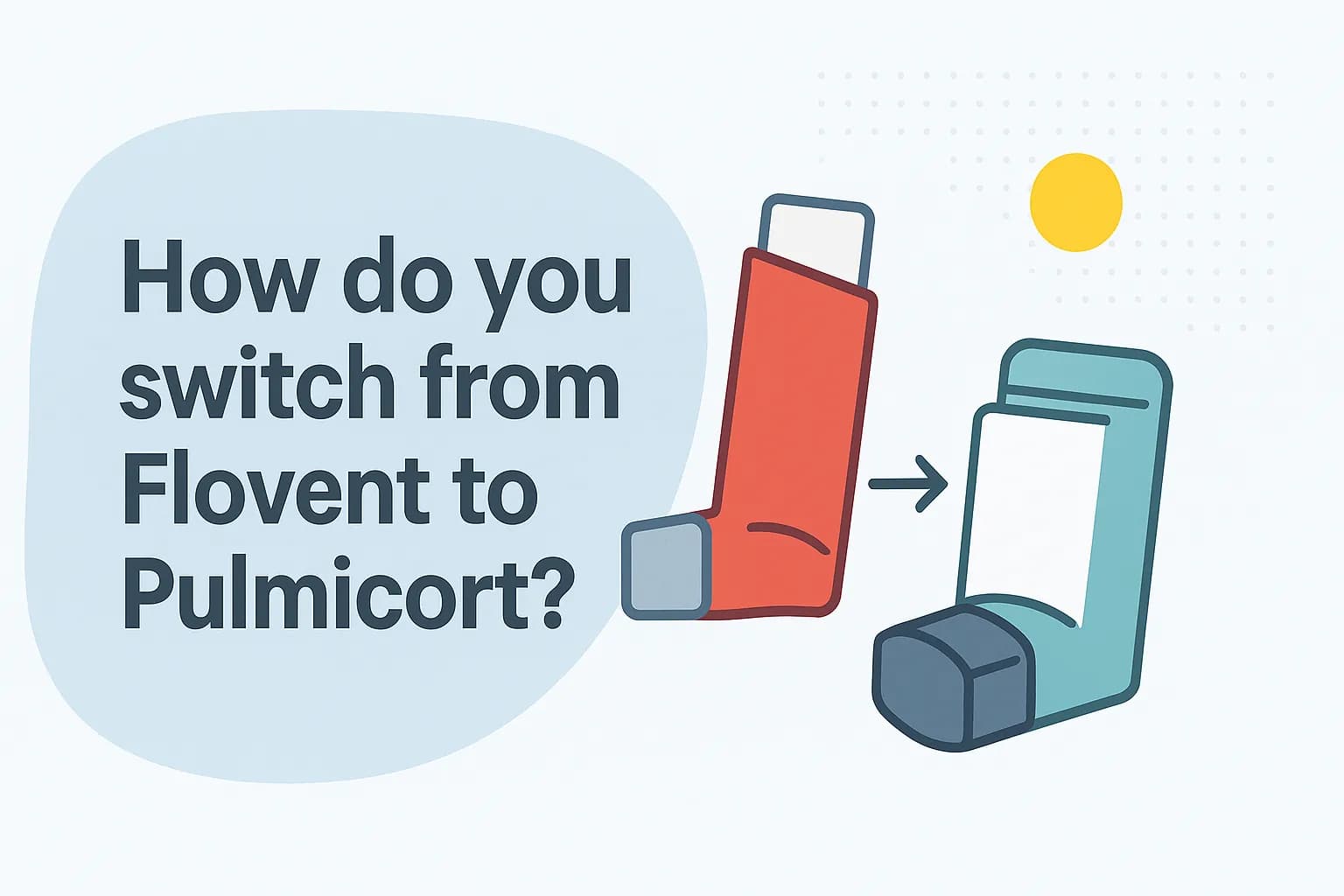How do you switch from Flovent to Pulmicort?

Last year, GlaxoSmithKline (GSK) informed the US Food and Drug Administration (FDA) of their plans to discontinue the brand-name asthma medications Flovent HFA (fluticasone propionate inhalation aerosol) and Flovent Diskus (fluticasone propionate inhalation powder) and replace them with authorized generic versions of these medications. For some Americans, that means they will need to switch to a new inhaled medication to maintain good asthma control. One of these medications is Pulmicort (budesonide). Like Flovent, it is an inhaled corticosteroid that is typically taken twice a day. It is available as a metered-dose inhaler (Pulmicort Flexhaler) and a nebulizer solution (Pulmicort Respules).
If you are interested in switching to Pulmicort from Flovent:
- Do not suddenly stop using your Flovent inhaler. This could worsen your asthma symptoms.
- Talk to your healthcare provider about switching. After reviewing your medical history, allergies, and other prescription drugs, over-the-counter medications, vitamins, and supplements you are taking, they will determine if changing inhalers is right for you.
- Review instructions on how to use your new inhaler with your pharmacist. Be sure you understand how to use it, how often you use it, as well as if you need to prime or clean it. You should also discuss any questions you have concerning side effects and drug interactions with them before beginning treatment.
- Remember that the Pulmicort Flexhaler or other alternatives are not rescue inhalers. They are a maintenance treatment to help prevent and manage symptoms. For sudden breathing problems, shortness of breath, or asthma attacks, you will still need to use your rescue inhaler.
If you cannot take Pulmicort, there are plenty of other options that you can try. Some other inhaled corticosteroids include ArmonAir Digihaler (fluticasone propionate), Arnuity Ellipta (fluticasone furoate), Qvar Redihaler (beclomethasone), Alvesco (ciclesonide), Asmanex HFA (mometasone), and Asmanex Twisthaler (mometasone).
There are also inhalers that contain some combination of inhaled corticosteroids, long-acting beta-agonists (LABAs), and/or anticholinergics that are effective in the treatment of asthma. Examples include Breztri (budesonide/glycopyrrolate/formoterol), Symbicort (budesonide/formoterol), Breo Ellipta (fluticasone furoate/vilanterol), Trelegy Ellipta (fluticasone furoate/umeclidinium/vilanterol), Dulera (mometasone/formoterol), and Advair Diskus (fluticasone/salmeterol).
What is Flovent?
Flovent contains the active ingredient fluticasone propionate. It is an inhaled corticosteroid used in people 4 years of age and older with persistent asthma. It helps reduce inflammation in your lungs to keep your airways open. When used every day, Flovent can reduce the number and severity of asthma attacks. It is not a rescue inhaler like albuterol, so it will not help with sudden breathing problems. Fluticasone propionate is also not approved to treat chronic obstructive pulmonary disease (COPD) but is frequently combined with a bronchodilator in products such as Advair Diskus to manage this condition.
What is the typical dosage for Flovent?
Flovent is available as an aerosol inhaler (Flovent HFA) and a dry powder inhaler (Flovent Diskus), both of which are typically taken twice a day.
Flovent HFA is available in 3 strengths – 44 mcg/actuation, 110 mcg/actuation, and 220 mcg/actuation.
Flovent Diskus is also available in 3 strengths – 50 mcg/actuation, 100 mcg/actuation, and 250 mcg/actuation.
- Patients 12 years of age and older: 88 mcg twice a day. Max dose: 880 mcg twice a day.
- Patients 4 to 11 years: 88 mcg twice a day.
- Flovent Diskus 12 and older: 100 mcg twice a day. Max: 1,000 mcg twice a day.
- Flovent Diskus 4 to 11 years: 50 mcg twice a day. Max: 100 mcg twice a day.
Your doctor may adjust your dose based on your response and previous treatment.
What are the most common side effects of Flovent?
- Throat irritation
- Headaches
- Cough
- Nasal congestion
- Upper respiratory tract infection
- Sinus infection or swelling
- White patches in your mouth (thrush)
- Hoarseness
Rare side effects include:
- Acute asthma exacerbations
- Vision problems
- Serious allergic reactions
- Bone loss (osteoporosis)
- Changes in cortisol levels
- Delayed growth in children
These are not all possible side effects. Contact your healthcare provider for advice or report to the FDA at 1-800-FDA-1088 or www.fda.gov/medwatch.
Who should not use Flovent?
Do not use Flovent if you are allergic to fluticasone propionate or any inactive ingredients in the product. It is not for use during an asthma attack.
What is Pulmicort?
Pulmicort contains budesonide, an inhaled corticosteroid that lowers inflammation in the lungs to prevent asthma attacks. It is not a rescue inhaler and must be used regularly to be effective.
What is the typical dosage for Pulmicort?
Pulmicort is available as:
- Inhalation powder (Pulmicort Flexhaler): 90 mcg/actuation, 180 mcg/actuation
- Nebulizer solution (Pulmicort Respules): 0.25 mg/2mL, 0.5 mg/2mL, 1 mg/2mL
Pulmicort Flexhaler:
- Adults (18+): 360 mcg twice a day; Max: 720 mcg
- Children 6–17: 180 mcg twice a day; Max: 360 mcg
Pulmicort Respules:
- Pediatric (1–8 yrs, no prior ICS): 0.5 mg/day
- Pediatric (1–8 yrs, prior ICS): 1 mg/day
- Symptomatic children: Start with 0.25 mg every 12 hrs
What are the most common side effects of Pulmicort?
- Common cold symptoms
- Stuffy nose
- Sore throat
- Allergic rhinitis
- Upper respiratory infection
- Nausea
- Stomach flu
- White patches in mouth (thrush)
Rare side effects include:
- Acute asthma exacerbations
- Vision problems
- Serious allergic reactions
- Bone loss (osteoporosis)
- Changes in cortisol levels
- Delayed growth in children
Contact your healthcare provider or report side effects to the FDA at 1-800-FDA-1088 or www.fda.gov/medwatch.
Who should not use Pulmicort?
Do not use Pulmicort if you are allergic to budesonide or any inactive ingredients in the product. It is not a rescue inhaler and should not be used during asthma attacks.
Is Fluticasone stronger than Pulmicort?
Fluticasone propionate is stronger than budesonide in terms of receptor binding and anti-inflammatory effect. However, that does not always mean better results. Effectiveness depends on individual response.
Is Fluticasone better than Pulmicort?
Both Fluticasone and Pulmicort are taken twice daily for asthma control and can take up to 2 weeks for full effect. Clinical trials show they are similarly effective with similar safety profiles. The best choice depends on how your body responds, which your doctor can help determine.
Is Pulmicort a steroid?
Yes. Pulmicort contains budesonide, an inhaled corticosteroid that reduces inflammation in the lungs to improve breathing. It must be used regularly and does not work for sudden symptoms.

